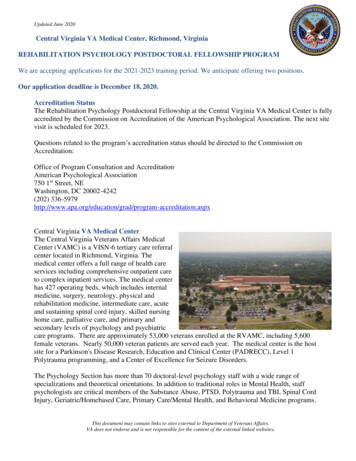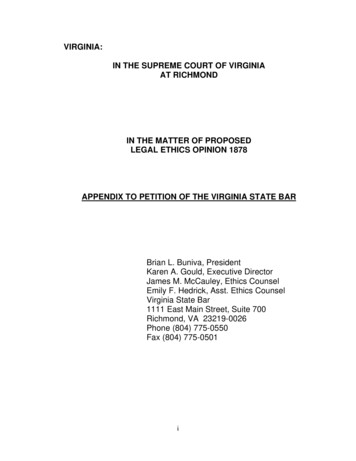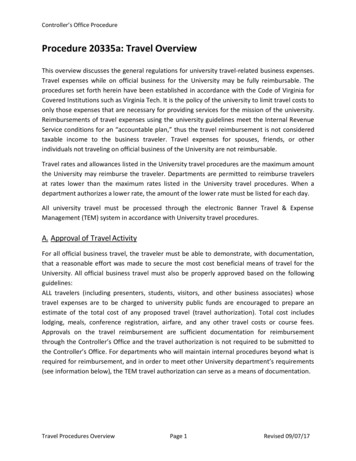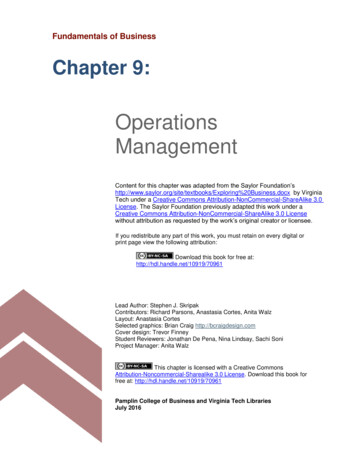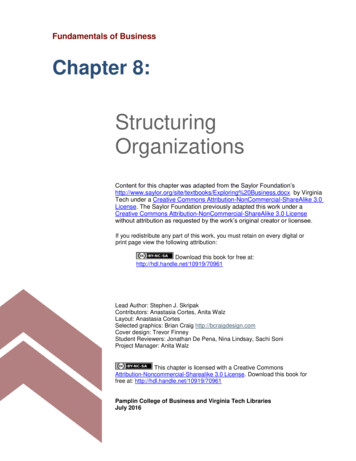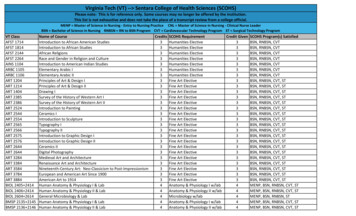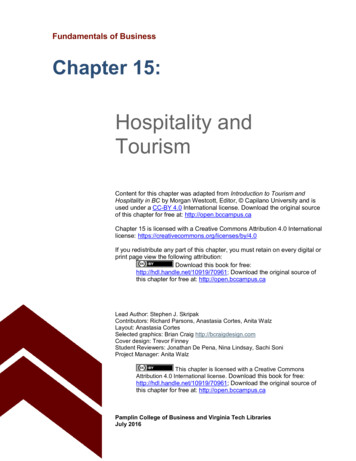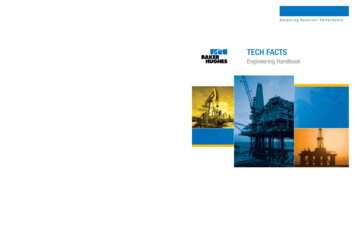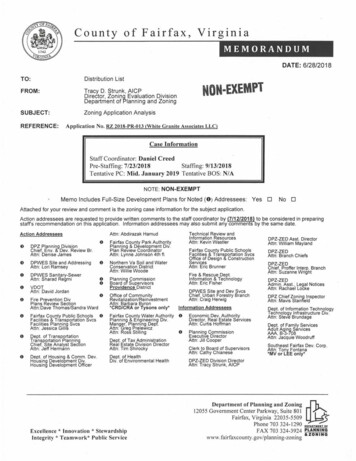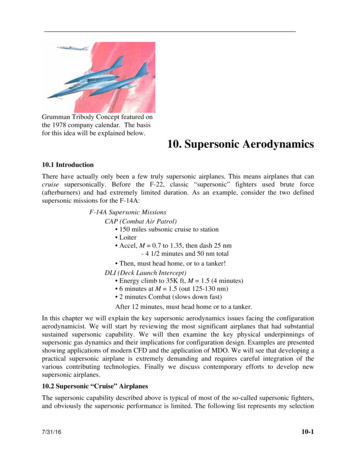
Transcription
Grumman Tribody Concept featured onthe 1978 company calendar. The basisfor this idea will be explained below.10. Supersonic Aerodynamics10.1 IntroductionThere have actually only been a few truly supersonic airplanes. This means airplanes that cancruise supersonically. Before the F-22, classic “supersonic” fighters used brute force(afterburners) and had extremely limited duration. As an example, consider the two definedsupersonic missions for the F-14A:F-14A Supersonic MissionsCAP (Combat Air Patrol) 150 miles subsonic cruise to station Loiter Accel, M 0.7 to 1.35, then dash 25 nm- 4 1/2 minutes and 50 nm total Then, must head home, or to a tanker!DLI (Deck Launch Intercept) Energy climb to 35K ft, M 1.5 (4 minutes) 6 minutes at M 1.5 (out 125-130 nm) 2 minutes Combat (slows down fast)After 12 minutes, must head home or to a tanker.In this chapter we will explain the key supersonic aerodynamics issues facing the configurationaerodynamicist. We will start by reviewing the most significant airplanes that had substantialsustained supersonic capability. We will then examine the key physical underpinnings ofsupersonic gas dynamics and their implications for configuration design. Examples are presentedshowing applications of modern CFD and the application of MDO. We will see that developing apractical supersonic airplane is extremely demanding and requires careful integration of thevarious contributing technologies. Finally we discuss contemporary efforts to develop newsupersonic airplanes.10.2 Supersonic “Cruise” AirplanesThe supersonic capability described above is typical of most of the so-called supersonic fighters,and obviously the supersonic performance is limited. The following list represents my selection7/31/1610-1
10-2 Configuration Aerodynamicsof the previous manned supersonic aircraft. It is a very short list. It is important for aerodynamicdesigners to be familiar with these airplanes. The L/Ds given below are for supersonic flight. 1956: the B-58 (L/Dmax 4.5) Convair, 1st flight Nov. 1956,–In 1962: Mach 2 for 30 minutes 1962: the A-12 (SR-71 in ’64) (L/Dmax 6.6), Lockheed, 1st flight April 1962 (A-12),the 1st SR-71 flight was in Dec. 1964–1st supersonic flight, May 4, 1962–1st flight to exceed Mach 3, July 20, 1963 1964: the XB-70 (L/Dmax 7.2) North American Aviation, 1st flight Sept. 1964– 1st Mach 3 flight Oct. 1965, In 1966: flew Mach 3 for 33 minutes 1968: the TU-144, Tupolev–1st flight: Dec. 31, 1968 1969: the Concorde (L/Dmax 7.4) Aérospatiale/BAC design–1st flight, March 2, 1969, 1st Mach 2 flt., Nov. 4, 1970)* 1990: the YF-22 and YF-23 (supercruisers)–YF-23: Northrop led team, 1st flt. Aug. 27, 1990–YF-22: Lockheed led team, 1st flt. Sept. 29, 1990, F-22 1st flt. Sept. 7, 1997Note the low L/D values associated with supersonic flight. Nevertheless, these airplanes were allremarkable.10.2.1 The B-58The B-58 is shown in Figure 10-1. It is a strikingly attractive design. It followed the Convairapproach of using a conically cambered delta wing in the tradition of the F-102 (1st flight 1953)and F-106 (1st flight 1956) airplanes from the same company.Today B-58s can be seen at numerous museums, notably the Museum of the Air Force inDayton, Ohio, and the Pima Air & Space Museum outside of Tucson, Arizona.The B-58 had a three-man crew and weighed around 160,000 pounds, of which over 100,000pounds was fuel! The structural weight fraction was an amazingly low 14%. To achieve therequired aerodynamic performance the wings were thin, 4.08% at the tip and 3.46% at the root.In 1962 the B-58 flew 1300 mph for 30 minutes and 43 seconds, thus being the first airplane tofly over 2000 km/hr for 30 minutes, and was able to claim the Bleriot prize. It also set a recordflying from Los Angeles to New York in 2 hours and 57 seconds (for comparison the SR-71 latermade the trip in 68 minutes). The required static margin for longitudinal stability was 3%, butgreater than 3% was required for directional stability to handle the engine out case. An ARI(Aileron-Rudder Interconnect) was used to cancel the yawing moment due to aileron deflection.The plane was powered by four pylon mounted GE J-79 engines, making it an extremely loudairplane.One of the curious features was the use of a “double bubble” attached pod below the fuselage.The outer pod carried fuel and was jettisoned when empty. The inner pod was in fact the nuclearbomb.*The last flights of the Concordes occurred on October 24, 2003.7/31/16
W.H. MasonSupersonic Aerodynamics 10-3The best paper to read on the B-58 is by Erickson.1 The airplane had a poor safety record. In partthis was because the tires were very small to allow the gear to fit in the fuselage. The takeoff andlanding speeds were high, and the tires sometimes blew up. It was also very difficult to maintain.Figure 10-1. The B-58 in flight.10.2.2 The SR-71 FamilyThis is probably the most amazing design achievement ever made in aeronautics. Figure 10-2shows this familiar airplane. The SR-71’s predecessor, the A-12, first flew in 1962, while theSR-71’s first flight occurred in 1964. It served for many years after having been developed incomplete secrecy. The definitive paper on the aerodynamics of the SR-71 (on “the edge”between supersonic and hypersonic flight) was written by Ben Rich,2 who later went on to be akey member of the team that developed the F-117 stealth “fighter”. It is impossible to provide abetter description of the plane than the one given by Rich. Aerodynamic heating was also animportant consideration on the design. It was powered by two Pratt J-58 turboramjet engines.The SR-71 had a crew of two. Its wing area was 1800 sq ft, the span was 55 ft 7 in, and theMTOGW was 172,000 lb. Its last military flight was in 1990. NASA operated SR-71sporadically until 1999.Another good description is available in the AIAA book by Peter Merlin.3 That book comes witha DVD that has a wealth of information including flight manuals, photos and videos.7/31/16
10-4 Configuration AerodynamicsFigure 10-2. The SR-71.10.2.3 The XB-70The XB-704 is shown in Figures 10-3 and 10-4. The airplane was intended to be a Mach 3intercontinental bomber. However, the successful development of ICBMs meant there was nolonger a need for the plane, instead it became a research airplane. Two were built. It was a largeairplane with a wing area of 6297 sq ft, a span of 105 ft, and a MTOGW of 542,000 lb. In May1966 the XB-70 flew at Mach 3 for 33 minutes. It had six GE YJ93 engines.It only reached Mach 3 a few times. This was in part because the second airplane was destroyedin a mid-air collision with an F-104 in June of 1966 during a publicity photo flight for GeneralElectric. Joe Walker, the pilot of the F-104, was killed (XB-70 pilot Carl Cross also died, AlWhite survived) To increase directional stability and minimize the aerodynamic center shift theXB-70 deflected its wingtips down in supersonic flight. This is shown in Fig. 10-4. Only thesecond airplane had the full wingtip deflection capability.Although it was also said to have increased aerodynamic efficiency through the use of“compression lift” on the lower surface, this could have been achieved by mild wing camber.Note that the canard is essentially a foreplane, acting as a trimmer. It also had a very high basedrag associated with the propulsion installation in the transonic flight regime.The remaining XB-70 is on display at the National Museum of the Air Force in Dayton, Ohio. Itwas flown to Dayton in February 1969.7/31/16
W.H. MasonSupersonic Aerodynamics 10-5Figure 10-3. The XB-70 on takeoff. Note the large delta wing. The canard is essentiallya trimmer.Figure 10-4. This figure shows the XB-70 flying with its wing tips deflected down.7/31/16
10-6 Configuration Aerodynamics10.2.4 The TU-144The Tupolev TU-144 was a Soviet Union contemporary of the Concorde. It flew before theConcorde, on December 31, 1968. Fifteen were built. It was similar in configuration to theConcorde with the notable exception that it had a retractable “mustache” canard (as well as thedrooping nose used by the Concorde). It also had a braking parachute, very unusual for acommercial airplane. The program suffered when a TU-144 crashed during a demonstrationflight at the Paris Airshow in June 1973. Although it made a number of operational flights, itwasn’t practical and the program ended. It was resurrected during the US HSCT program in the1990s when it was used by NASA as a testbed for supersonic flight research. The TU-144 iscited as having a wing area of 5450 sq ft, a span of 94.4 ft, and a max TOGW of 455,950 lb.10.2.5 The ConcordeThe development of the Concorde, together with a discussion of the Russian SST effort and theaborted attempt by the US, is described in a wonderful paper by Poisson-Quinton5 (that paperincludes data showing how the TU-144 used the “mustache” canard). The AIAA published acase study on the Concorde6 that provided a description of its aerodynamic design. Figure 10-5 isa photo from the Smithsonian web site that shows the Concorde planform. The Concorde has awing area of 3856 sq ft, a span of 84 ft, and a max TOGW of 412,000 lb. The aerodynamicdesign of the wing is described in a paper by Wilde and Cormery.7 To allow the slender wingconfiguration to land and takeoff at an acceptable angle of attack the Concorde took advantage ofvortex lift as well as ground effects. During the years that the Concorde was in service I saw itfrequently, both flying over Long Island on its was to Kennedy Airport, taxiing around Kennedyand also at London Heathrow. Compared to the other planes it was small, and the wing wasextremely thin. One of the most notable aspects of its flight was how loud it was. If it had flownover my house more than once a day it would have been very annoying, even to me (and I livedabout 35 miles from the airport).Figure 10-5 The Concorde (from the Smithsonian website)7/31/16
W.H. MasonSupersonic Aerodynamics 10-710.2.6 The F-22 (YF-23)During the late 1970s and the 1980s the US Air Force studied the requirements for a new fighter.A key requirement was found to be “supercruise” wherein the airplane could fly supersonicallywithout the use of the afterburner. This decreases fuel burn and allowed for significantly longersupersonic range than previous fighter aircraft. Stealth was also important, but not publiclydiscussed. The fighter requirement became official as the ATF (Advanced Tactical Fighter) in1981. In 1986 teams led by Northrop (YF-23) and Lockheed (YF-22) won awards to builddemonstrators. In 1991, after the flight demonstrations were completed, Lockheed was awardedthe contract for the F-22. This process is described in detail in the AIAA book by Aronstein,Hirschberg and Piccirillo.8 A description the F-22 aircraft was given in the 1992 Wright BrothersLecture by Sherman Mullin.9 A photo of the F-22 is shown in Figure10-6.Figure 10-6. The Lockheed F-22 (from the web)10.3 The Challenge for Airplane DesignFrom this small number of actual supersonic cruising airplanes, we see that supersonic flight is achallenge. We can get some insight from the range equation:(10-1)Here we have to counterbalance the reduction in L/D as shown above for these airplanes with anincrease in V (recall that subsonic transport L/Ds should be between 18 and 20). However, we7/31/16
10-8 Configuration Aerodynamicsalways incur the extra cost of supersonic wave drag. We also need to be able to fly withoutafterburner to keep the sfc low. This is difficult because modern transonic transports use highbypass ratio engines. The large engine/nacelle diameters are not possible at supersonic speeds, thedrag would be unacceptable. Thus we have numerous challenges for economical supersonic flight.The basic physics of the flowfield change between sub- and super-sonic flow. This is illustrated inthe figure originally presented by von Kármán 10 in Figure 10-7.Figure 10-7. The change in flowfield physics from subsonic to supersonic speeds asexplained by Kármán.10 (a) stationary source, (b) source moving at half thespeed of sound, (c) source moving at the speed of sound, (d) source movingat twice the speed of sounds.Poisson-Quinton5 has shown how the wave drag leads to a reduction in L/D at supersonic Machnumbers. This is illustrated in Figure 10-8. The chief culprit is the CD0 increase with Machnumber due to the volumetric wave drag. Nicolai has collected the minimum drag values for anumber of supersonic fighters. Figure 10-9 is from his book.11 Clearly the wave drag is large. Formodern supersonic designs the drag increase would be much less. However this figure providesinsight into the challenge.7/31/16
W.H. MasonSupersonic Aerodynamics 10-9Figure 10-8. The L/D problem for supersonic flow.5Figure 10-9. CD0 increase with Mach number (Nicolai11)A key overview of the supersonic aerodynamic design issues has been written by Baals, et al.12That paper provides a basis for thinking about supersonic airplane design and should be studied7/31/16
10-10 Configuration Aerodynamicsfor the details of the aerodynamic design thinking used in the US SST program to be describedlater.In addition to the pure aerodynamic performance challenge, supersonic airplanes must addressthe noise problem, both around the airport (so-called community noise) and the sonic boom. Thisproved to be a significant issue during the studies of a possible new supersonic transport in the1990s, the HSCT.13 That airplane was intended to operate at Pacific-rim ranges with from 250300 passengers. More recently, the possibility of designing small business-jet class supersonicairplanes with an acceptable level of boom noise is under study.14,15 It is likely that theseairplanes will be the next generation of supersonic airplanes, and we will discuss the boom issuesbelow in Section 10.10.4.Next, to understand some of the key aerodynamic ideas we will be break our discussion into twoparts. First we will present an overview of z
Dayton, Ohio, and the Pima Air & Space Museum outside of Tucson, Arizona. The B-58 had a three-man crew and weighed around 160,000 pounds, of which over 100,000 pounds was fuel! The structural weight fraction was an amazingly low 14%. To achieve the required aerodynamic performance the wings were thin, 4.08% at the tip and 3.46% at the root. In 1962 the B-58 flew 1300 mph for 30 minutes and 43 .
